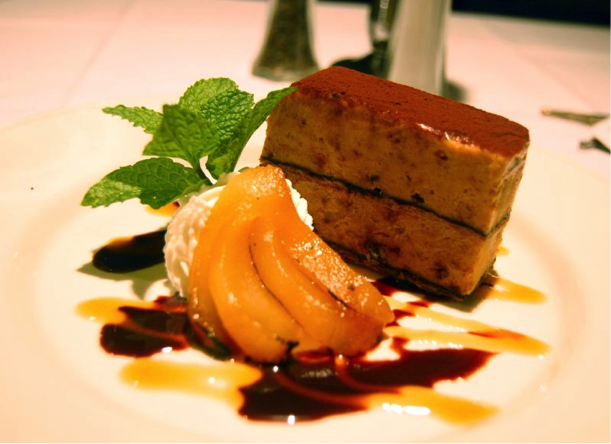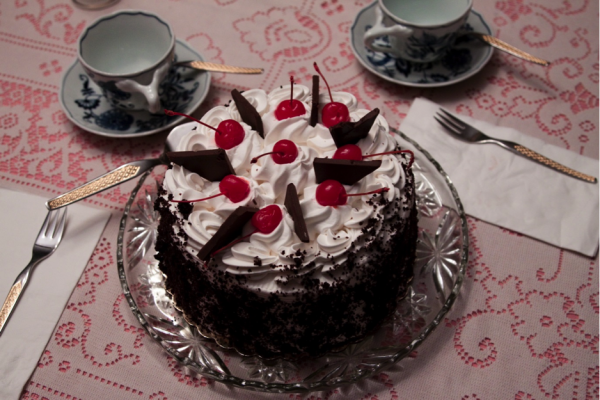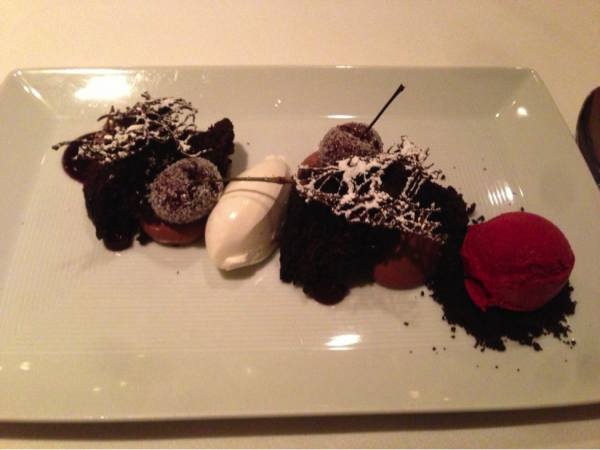Dessert Presentation
11 Prepare and Plan Dessert Menus
Finding inspiration and developing a great plated dessert is a chore in itself. But having to plan an entire dessert menu, to strike a balance of items to be offered, to choose items that will be attractive to your customers and promote good sales takes planning.
Establishments that have the most success with their dessert menu (and sales) tend to stick to the most popular flavours. Innovation just for innovation’s sake is generally not a good idea. Non-traditional ingredient pairings may work, for example, and chocolate always sells well—but if it is combined with something like beets, it will turn most people off. There is a time and place for uncommon dessert ingredients: special events, tasting menus, catering events. Desserts are a comfort food to most people, and to have an approachable menu with popular flavours will lead to the highest customer satisfaction.
A good starting point is the 5 Cs:
- Chocolate
- Citrus
- Coffee
- Custard or cheesecake
- Caramel
Chocolate
The chocolate dessert is probably the most popular one at any restaurant. Always have one dark chocolate dessert. If you need a second chocolate dessert, go with one made with white chocolate, milk chocolate, or some variation. Using a good-quality chocolate can turn a simple dessert into one with a “wow factor.” Many consumers have an understanding of the differences in chocolates, so by using a high-percentage, single-origin chocolate, the unique flavours can tell a “story” on the dessert menu.
Citrus
Many people who aren’t chocolate lovers tend to be fans of citrus. Citrus is very refreshing and can be used in many different applications.
Coffee
Tiramisu is a modern classic made with coffee. An affogato is a super-easy dessert that combines two popular items: coffee and dessert. This can be a great starting point for designing a dessert: take a popular and enjoyable flavour combination, and add other elements to it.
Custard (or cheesecake)
Having a rich, creamy, custard-based dessert is always popular. Whether it is a classic cheesecake, a crème brûlée, a flan, or a bread pudding, this style of dessert will always be popular.
Caramel
There are so many delicious treats you can make with this flavour—toffee pudding, caramel parfait, caramel candies, caramel apples, caramel sundae, caramel ice cream served with crunchy toffee bits, and a heaping spoonful of crème fraîche caramel sauce.
Other principles to consider
- Keep the wording simple and straightforward.
- Try not to repeat ingredients. If bananas are used in one item, keep it that way. Why have two desserts with the same ingredient?
- You don’t always have to use fruit. If you are in an area that doesn’t produce much fruit in the shoulder seasons, use other ingredients.
- When it’s in season, use fruit. It is a great way to showcase an ingredient that people want to taste after a year of not having it. Using fruit will also lower your food costs, and you will have an ingredient that requires little manipulation.
- Not every dessert requires a frozen component.
- The number of dessert items on the menu depends on how the kitchen can handle serving them during busy production times, without compromising the customers’ experience. Normally five to eight items on the dessert menu is a reasonable amount.
- Design a dessert menu that suits the style and cuisine type of the establishment, as well as the type of customers being served.
- Think about seasonality: offer lighter desserts in summer, richer, warmer desserts in the winter.
- Put the popular items on the very top and bottom of the menu so that customers will see the other options and perhaps choose them. Also, statistically, when a person views a menu, the eye will be drawn to the top, right-hand side of the page. Placing a less popular item in this area can help promote sales of desserts that are not the “stars.”
- Keep it small. There is nothing that better promotes customer satisfaction than to have them wishing for a “little bit more” of a dessert. You don’t want to serve a dessert that is so big it can’t be finished. This will have an effect on the customer (“I’ve had too much”), and is wasteful. Food costs can be lowered if reasonable portion sizes are used. By serving smaller amounts, greater yield can come from the recipes.
Designing a dessert
Where do you start in planning a new dessert? Once you have the main ingredient or flavour profile figured out, there are many options:
Favourites
Take classic, popular desserts (hot soufflés, crème brûlée, lemon tarts, etc.) and prepare and present them in a clean, straightforward manner. Remember that classics are classics for a reason. They are great dishes, have wonderful contrasts, and are comforting. They can remind customers of times past and conjure the great memories that accompany them. A dessert that is simple, but executed perfectly, is very satisfying on many levels.
Ingredient driven
Say you have fresh, ripe, juicy peaches. By using the principles listed above about contrast between flavour, texture, and temperature, you can design a peach dessert. For example, you might offer a slice of sponge cake soaked with a vanilla syrup and topped with sliced peaches. Or you might present a white wine sabayon pooled on top of the peaches and then flashed under a broiler, or use a hand torch to caramelize the top, finished off with a drizzle of wildflower honey. Use the different textures from the fruit and sponge cake, and the creamy sabayon, which is on the tart side, to balance the sweetness of the fruit and honey. Warmth from the broiler will contrast the lower temperature of the other components. Figure 10 shows an example of a dessert that features peaches and walnuts.
Seasonal
Use a fruit (or vegetable) and make it a “star” in the season it is harvested. For example, prepare apple desserts to serve in the fall and winter, and local strawberries and ice cream in the summer.

Deconstruct a recipe
Take the main flavour profiles of a classic dessert or combination, and reinterpret them in an intriguing fashion. For example, turn a black forest cake (Figure 11) into a plated dessert. The eponymous black forest cake of chocolate layers, whipped cream, cherry centre, and cherry topping has been very popular for over half a century, and it is a combination of flavours that everyone knows.

First, take the key components of the black forest cake (chocolate, cherries, and whipped cream) and come up with different ways to reimagine them in a modern context (Table 2).
| Component | Reimagined |
|---|---|
| Chocolate cake | Rich chocolate brownie, broken into pieces; chocolate “sand” made with tapioca maltodextrin |
| Whipped cream | Crème fraiche – shaped into a quenelle |
| Cherries soaked in kirsch | Candied cherries and cherry–kirsch sorbet |
Next, think about assembly. One option is to assemble the dessert with the brownie pieces placed on the plate first, then the crème fraiche in the centre of that, garnished with candied cherries and finished with a scoop of the cherry sorbet resting on the chocolate “sand.” The plate could be finished with some sauce and garnishes (Figure 12). This “deconstruction” has all the flavours of a classic black forest cake, but is presented in a novel format and designed with contrasts of flavour, textures, and temperatures in mind.

Now that you have an inspiration for a dessert, next comes the planning stage. This is where the design principles mentioned above apply. An easy way to plan is to draw the dessert. Putting the idea on paper can assist with placement of the components, the shapes, the scale of each component to the others, and potential garnishes. To ensure the execution of all the components balances, be prepared to make the dish over and over, tweaking the items each time. That will be the only way to ensure that you have created a memorable dessert!
Media Attributions
- Peach Walnut Semifreddo © Ulterior Epicure is licensed under a CC BY-NC-ND (Attribution NonCommercial NoDerivatives) license
- Black Forrest German Cake © Eric is licensed under a CC BY-NC-ND (Attribution NonCommercial NoDerivatives) license
- Deconstructed Black Forest Cake © Jenny Cu is licensed under a CC BY (Attribution) license

